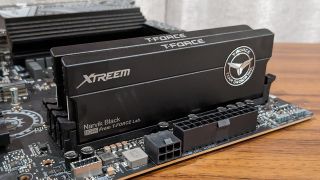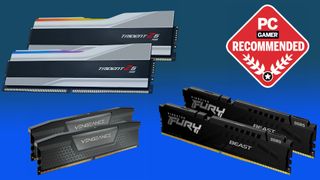DDR5-10000 memory is closer than ever after JEDEC, the managing body of the standard, extends the base DDR5 spec
Let's see what those next-gen CPUs are capable of.

The march towards DDR5-10000 continues. Although overclockers have already well and truly passed that mark, those kinds of speeds are all but out of reach without extreme cooling and you have the combination of top quality memory and a CPU with an equally good memory controller.
JEDEC is the body that defines and maintains the DDR5 memory specification. Now, news comes via Anandtech, revealing that JEDEC has extended the official specification from 6400 MT/s up to 8800 MT/s speeds. That doesn't mean you'll see DDR5-8800 support on current hardware, but it does point towards an improvement in next generation memory ICs.
Memory manufacturers are free to push beyond that original 6400 MT/s limit. I reviewed a Teamgroup DDR5-8200 memory kit a little while back. It was difficult to run on a four-slot motherboard, but it serves as an example of how JEDEC standards are more of a baseline rather than reflective of the specs of what's on the market.
The 8800 MT/s spec includes 62-62-62 primary timings—at best. Compare that to the aforementioned Teamgroup kit with its 38-49-49 timings. Those JEDEC timings are essentially there for the enterprise market, where memory stability is paramount.

Best DDR5 RAM: the latest and greatest
Best DDR4 RAM: affordable and fast
This news leaves me excited for what we might see from next generation hardware. At this point we have no idea of the memory capabilities of AMD's Zen 5 or Intel's Arrow Lake CPUs, but if DDR5-8800 becomes a baseline over the next couple of years, it really is only a matter of time before DDR5-10000 kits become a reality.
I predict we'll see a retail DDR5-10000 kit within a year. In fact, I wouldn't be surprised to see such a kit at this year's Computex, even if it is just a binned kit with a sticker on it for show, alongside a demo on a highly binned CPU.
OK, gamers don't need 10000 MT/s speeds unless you're trying to extract every last frame from your system, but if your next system supports such speeds, and it's available for a reasonable price without crazy high timings, it'll become easier to justify. A DDR5-6000 kit was considered a premium option when it launched alongside 12th Gen CPUs. Now it's considered mainstream, and such kits don't cost a lot more than slower kits.
The biggest gaming news, reviews and hardware deals
Keep up to date with the most important stories and the best deals, as picked by the PC Gamer team.
DDR6 would appear to be several years away, so DDR5 isn't going anywhere. In fact, it might just be getting started.

Chris' gaming experiences go back to the mid-nineties when he conned his parents into buying an 'educational PC' that was conveniently overpowered to play Doom and Tie Fighter. He developed a love of extreme overclocking that destroyed his savings despite the cheaper hardware on offer via his job at a PC store. To afford more LN2 he began moonlighting as a reviewer for VR-Zone before jumping the fence to work for MSI Australia. Since then, he's gone back to journalism, enthusiastically reviewing the latest and greatest components for PC & Tech Authority, PC Powerplay and currently Australian Personal Computer magazine and PC Gamer. Chris still puts far too many hours into Borderlands 3, always striving to become a more efficient killer.
Most Popular






